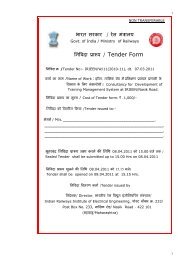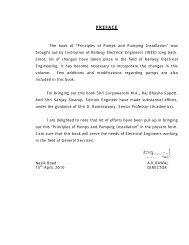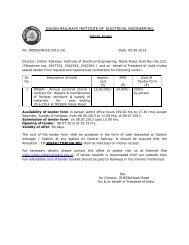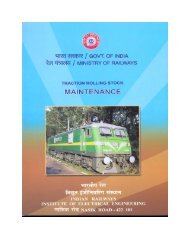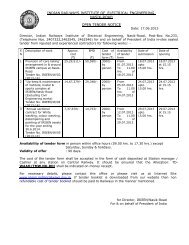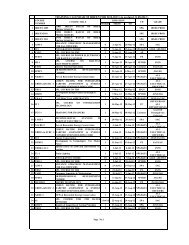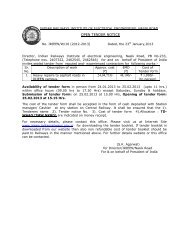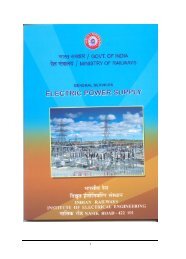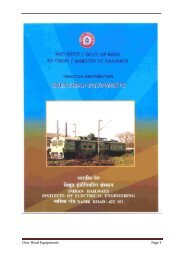remote control equipment - Indian Railways Institute of Electrical ...
remote control equipment - Indian Railways Institute of Electrical ...
remote control equipment - Indian Railways Institute of Electrical ...
Create successful ePaper yourself
Turn your PDF publications into a flip-book with our unique Google optimized e-Paper software.
1. GENERAL DESCRIPTION OF FIXED INSTALLATIONS<br />
1.0 POWER SUPPLY ARRANGEMENTS AT SUB-STATIONS<br />
1.0.1. Power Supply<br />
25 kV, AC, 50 Hz single phase power supply for electric traction is derived<br />
from the grid <strong>of</strong> State Electricity Boards through traction sub-stations located along<br />
the route <strong>of</strong> the electrified sections at distance <strong>of</strong> 35 to 50 km apart. The distance<br />
between adjacent substations may however be even less depending on intensity <strong>of</strong><br />
traffic and load <strong>of</strong> trains.<br />
At present there are broadly four different arrangement in existence as under<br />
1. The Supply Authorities supply power at 220/132/110/66 kV Extra High<br />
Voltage (EHV) at each traction substation which is owned, installed,<br />
operated and maintained by the <strong>Railways</strong>.<br />
2. The Railway receives 3-phase power supply from the supply Authority<br />
at a single point near the grid substation from where the Railway runs<br />
its own transmission lines providing its own traction sub-stations.<br />
3. All EHV and 25 kV <strong>equipment</strong> is owned, installed, operated and<br />
maintained by the Supply Authority except 25 kV feeder circuit<br />
breakers which are owned, installed, operated and maintained by the<br />
Railway.<br />
4. All EHV and 25 kV <strong>equipment</strong> is owned, installed, operated and<br />
maintained by the Supply Authority but 25 kV feeder circuit breakers<br />
alone are operated on <strong>remote</strong> <strong>control</strong> by the Traction Power Controller<br />
(TPC).<br />
1.0.2 Duplicate Supply<br />
1. Fig 2.01 shows schematically the arrangement at a typical traction substation.<br />
2. To ensure continuity <strong>of</strong> supply under all conditions, the high voltage<br />
feed to the traction substations is invariably arranged wither from two<br />
sources <strong>of</strong> power or by a double transmission line, so that if one<br />
source fails the other remains in service. Suitable protective <strong>equipment</strong><br />
is installed at the substations to ensure rapid isolation <strong>of</strong> any fault in<br />
transmission lines and substation <strong>equipment</strong>, so that the power supply<br />
for electric traction is maintained under all conditions.<br />
3. At each traction substation, normally two single phase transformers are<br />
installed, one which is in service and the other is 100% stand by. The<br />
present standard capacity is 21.6 MVA (ONAN)/30.2 MVA (ONAF).<br />
1




